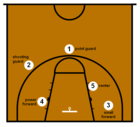Shooting Guard
The shooting guard [ ˈʃuːtɪŋ gɑːɹd ] (from English "shoot" throw ) is one of five positions in basketball . Together with the point guard , it forms the so-called backcourt . Alternatively, it is also called Two Guard , Off Guard (since it usually moves “off-side” of the player in charge of the ball), or simply two or 2 . The two guards are usually the smallest and fastest players on a basketball team.
In contrast to the point guard, who usually builds the game, the shooting guard is traditionally specialized in throwing from distance . The best known exceptions are Kobe Bryant and Michael Jordan , who were more known for their move to the basket or their post-play than for their distance throws.
History and style of play

The ability to score effectively from a distance was not available for Guards until the 1940s. On the one hand, there was no three-point line (it was only introduced in the NBA in 1979), on the other hand, the players threw both hands from the stand . Very few players managed to achieve an accuracy with this throwing technique that made them dangerous point collectors (e.g. Bobby McDermott ). The majority of the guards therefore limited themselves to the passing game. In the mid-1940s, various players developed a new throwing technique, the one-handed jump shot . This throwing technique, which is still in use today, also enabled the little players to score points from a distance. As early as 1948, Max Zaslofsky became the first guard top scorer in a professional league. And almost five years later, Bill Sharman was one of the first guards to have over 40% hit rate from the field.
Earl Monroe , one of the most conspicuous guards (according to today's definition: shooting guards) of the NBA in the 1970s, supplemented the usual style of play with a quick turning movement of the body, the so-called spin move . He was the first guard to launch an attack with his back to the basket, which was previously reserved exclusively for the centers and power forwards. He was also the pioneer of a series of guards who scored less by throwing from a distance than by pulling to the basket.
In the mid-1980s, Michael Jordan and Clyde Drexler , among others, started a trend towards shooting guards measuring just under two meters. Until then, the Shooting Guards were hardly bigger than the Point Guards, about 1.90 meters. The introduction of the three-point line in 1979 rewarded accuracy from a long distance, so that some shooting guards specialized in this distance throw (for example Reggie Miller and Jeff Hornacek ).
From the beginning of the 1990s, Michael Jordan set another trend by joining the low post as a guard . His trademark from later years, the turnaround jump shot (post fadeaway ), has since been adopted by a large part of today's shooting guard generation, such as Kobe Bryant and Tracy McGrady . The only shooting guards in NBA history to ever win an NBA Most Valuable Player Award were Michael Jordan (5 ×), Allen Iverson (1 ×), Kobe Bryant (1 ×) and James Harden (1 ×).
See also
Web links
|
||||||||||||||||||||||
